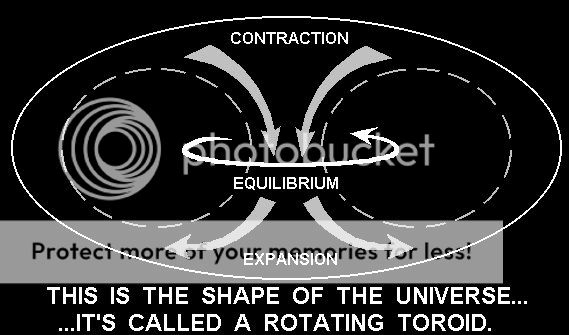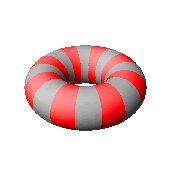Hypertorus
Produced by Andy Burbanks
If we take a vector from the origin to a point, and rotate that vector about the origin, then the point traces a circular path. If we do the same to another vector, about a different axis this time, and add the two together, then the resulting end-point will spiral around a donut or "torus'', which has a two-dimensional curved surface in 3-d space.
By adding a third vector, rotating about yet a different axis, we find that the end-point spirals around the 3-d surface of a "hypertorus'' in four-dimensional space.
Note: The projection into three dimensional space was achieved here by selecting a point in 4-space and "casting shadows'' from that point onto a 3-dimensional slice of the space. The fourth dimension is then made more apparent as extra depth in the image (objects that are closer to the camera in 4-space appear to bulge outward towards us, whereas objects further away in the 4th direction appear to shrink away)
Spinning Hypertorus
MOVIE
http://sun-cc208.lboro.ac.uk/departm...per/torus.html

 hopf fibration
hopf fibration
nested circles unite to form nested tori, as a current flows
http://www.youtube.com/watch?v=1yJ5EvV0K70

In geometry, a torus (pl. tori) is a surface of revolution generated by revolving a circle in three dimensional space about an axis coplanar with the circle. In most contexts it is assumed that the axis does not touch the circle and in this case the surface has a ring shape and is called a ring torus or simply torus if the ring shape is implicit. Other types of torus include the horn torus, which is generated when the axis is tangent to the circle, and the spindle torus, which is generated when the axis is a chord of the circle. A degenerate case is when the axis is a diameter of the circle and surface is a sphere. The ring torus bounds a solid known as a toroid. The adjective toroidal can be applied to tori, toroids or, more generally, any ring shape as in toroidal inductors and transformers. Real world examples of (approximately) toroidal objects include doughnuts, inner tubes, many lifebuoys, O-rings and Vortex rings.
In topology, a ring torus is homeomorphic to the Cartesian product of two circles: S1 × S1, and the latter is taken to be the definition in that context. It is a compact 2-manifold of genus 2. The ring torus is one way to embed this space into Euclidean space, but another way to do this is the Cartesian product of the embedding of S1 in the plane. This produces a geometric object called the Clifford torus, surface in 4-space.
The word torus comes from the Latin word meaning cushion.
http://en.wikipedia.org/wiki/Torus
 Consciousness, A Hyperspace View
Consciousness, A Hyperspace View - Saul Paul Sirag
ebook (39 pages)